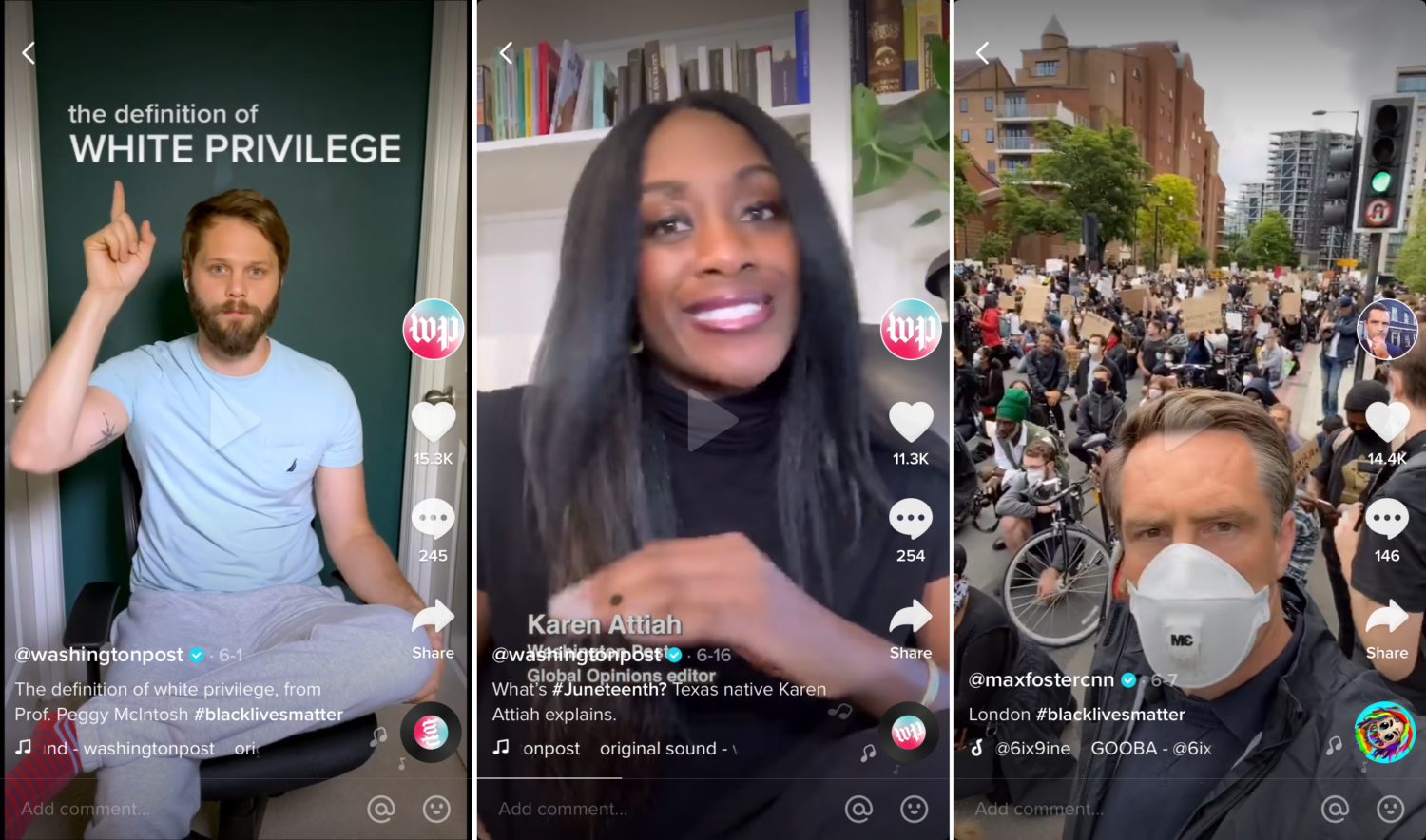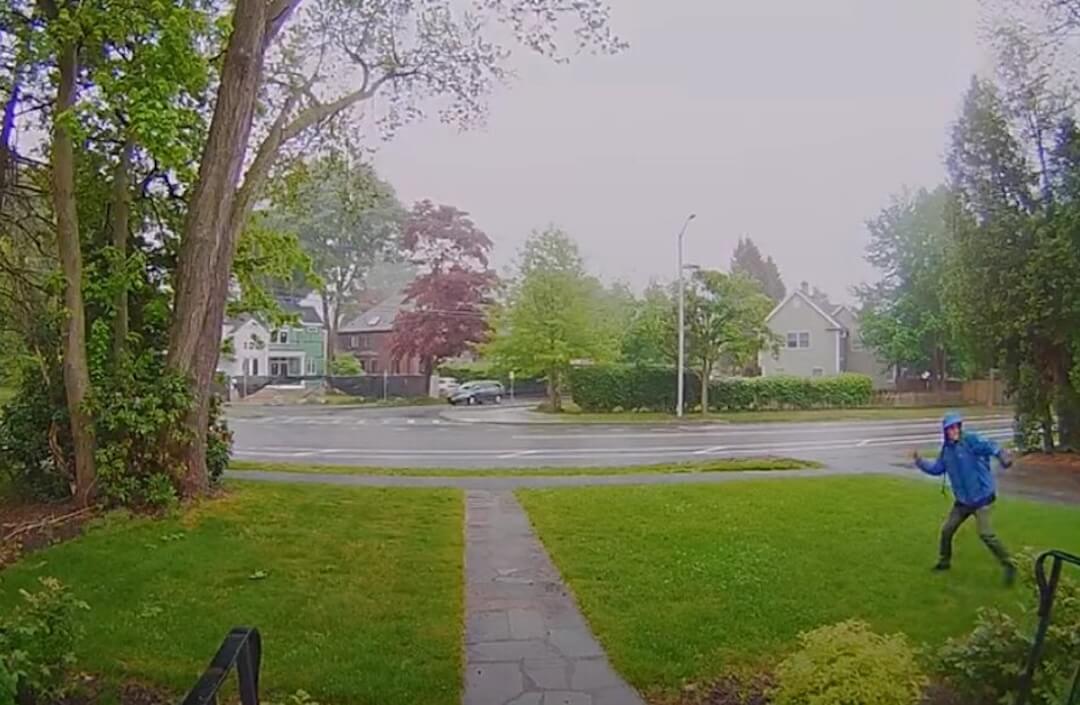CNN’s Max Foster started using TikTok to understand what his kids were up to online. He saw straight TikTok, where teenagers do choreographed dances from their parents’ homes. And he saw elite or alt TikTok, where users impersonate vegetables, retail brands and frogs. Mostly, he saw an opportunity for journalists.
“People talk about the trends being dances or music, but actually what I saw was trends in news,” he said.
Foster, a CNN anchor and correspondent based in London, began experimenting and making his own videos seven months ago. His first video, a goofy lip sync to a song about spicy peppermints, has over 183,000 views. In a more recent video, he lists COVID-19 related deaths in countries led by women. It has 2.3 million views.
Now, Foster’s personal account has more than 167,000 followers, nearly five times the number he has on Twitter. All of his content either explains the news or explains how he covers the news, and almost every video has a pop song in the background. TikTok’s “For You” page, where users spend an average of 52 minutes per day discovering new videos, uses an algorithm to recommend silly and serious videos based on songs, hashtags and even the kind of device a viewer is using.
Done well, there’s a way for journalists to connect with a wider, younger audience and even find stories through TikTok.
“People think that you can’t discuss complicated topics on TikTok, but that’s not true,” said Foster. “You just have to do it in a way that’s engaging and that’s what we should be doing as journalists anyway.”
TikTok content has gotten more serious recently: K-pop fans used the app in an attempt to foil Trump’s rally in Tulsa, Oklahoma; videos with the #BlackLivesMatter hashtag have received more than 13 billion views; and teenagers have formed virtual houses to share their political ideologies and persuade voters, even if they aren’t yet old enough to cast a ballot.
Though the industry has been using TikTok for over a year, few journalists have large, sustained followings. Some news outlets have gained upwards of 500,000 followers, but they tend to post branded content, not original content for TikTok. NowThis stands out in the pack with 1.5 million followers.
“What really tends to work is a genuine member of the community producing content in that language, in that space,” said Robert Hernandez, associate professor of professional practice at USC Annenberg’s School for Communication and Journalism.
Hernandez studies digital journalism and social media. He said journalists and news outlets that jump onto TikTok too quickly could end up looking like cool dads trying to sit at the kids’ table. Just as journalists must work to earn trust and credibility in the communities they cover, they must also work to earn the trust of the TikTok community.
Dave Jorgenson, video producer at the Washington Post and an ambassador for Poynter’s MediaWise, has earned the trust of nearly half a million followers. Jorgenson runs the Post’s TikTok account and is considered “the grandmaster of TikTok journalism” by Foster and many others in the community. Over the last year, Jorgenson has used the app to create goofy videos from the Post’s newsroom and promote its reporting. In one, he gets trapped in the office on Halloween. In another, he gets run over by Sen. Cory Booker. In several, he talks to a can of Spam.
MORE FROM POYNTER: How The Washington Post’s TikTok guy Dave Jorgenson gets millions of views by being uncool
At the beginning of the Black Lives Matter protests, Jorgenson began to post videos more directly related to the news. He handed over the platform to his Black colleagues to talk about their work and what it means to be a Black journalist today. Jonathan Capehart defined systemic racism in under 59 seconds. Karen Attiah explained Juneteenth. Robert Samuels detailed how U.S. cities failed to protect Black Americans early enough from the coronavirus.
Today’s @washingtonpost second quarantine TikTok features 59 seconds of @CapehartJ https://t.co/gvlUkjdxVf pic.twitter.com/aaqN7SHvwX
— Dave Jorgenson
(@davejorgenson) June 5, 2020
The moment was a segue for Jorgenson. Before June, he released more serious TikToks once every two weeks or so. But now, he releases one news-related video and one goofier video every day.
“The last few weeks have given me some confidence that it’s actually a good thing to include the hard news,” said Jorgenson. “I had some inklings that it would work, but I really wasn’t sure because I didn’t want to take away from the joy of the account.”
He said he’s reaching a larger, more diverse audience. In the comments section of videos about racial injustice, followers occasionally disclose their backgrounds as they engage in debates related to the news that can go on for over 100 comments. To encourage a sense of community, both Jorgenson and Foster frequently engage in the comments section of their videos, liking comments and replying to a few with witty emojis.
Neither is certain that journalists can survive on TikTok long term, though they’re both still steadily gaining followers. For now, Jorgenson and Foster view the app as one big experiment, a virtual playground filled with musical toys.
The experiment can be lucrative for news outlets. In December, the Post offered a yearlong subscription deal for TikTok fans. A promo code was featured in the account’s bio, which typically reads “We are a newspaper.” While the Post would not provide the number of people who used the promo code, they were very pleased with the engagement, director of communications Shani George wrote in an email to Poynter.
USC’s Hernandez said TikTok is a viable platform for communicating with large audiences, especially audiences that don’t typically consume journalism content. But he doesn’t think the app will hit the mass adoption level of Facebook, which has about 2.5 billion monthly active users, compared to TikTok’s 800 million. There’s a content creation hurdle; though typically less than a minute long, it takes time to splice together a video and incorporate catchy audio, especially if you’re hoping to go viral.
“What we’re seeing is very much in line with Snapchat, Instagram and Twitter, which all started as something ephemeral, something fun,” said Hernandez. “Then we realize that the platform is viable and complex and can take on serious topics.”
Christine Emba, opinion columnist and editor at the Post, was featured in one of Jorgenson’s recent humorous yet weighty TikToks. She viewed it as a teaching moment. TikTok can provide the initial exposure to an idea, and opinion pieces can provide a deeper analysis.
Today’s second @washingtonpost quarantine TikTok features a recreation of a real conversion with @ChristineEmba https://t.co/px5VlUicr0 pic.twitter.com/jZMvTSqOav
— Dave Jorgenson
(@davejorgenson) June 1, 2020
“This is a moment in which people seem finally open to talking about white supremacy, about structural racism, all of these things that we should be talking about more but are often a little bit too scared to get into,” said Emba. “This moment gives us a rare aperture to have these conversations publicly and share useful information and knowledge with a wider audience who are at this moment actively looking to learn more about these questions, even on TikTok.”
Jorgenson and Foster’s videos have prompted conversations about the news and about media literacy.
“TikTok can actually show people just how much work goes into a story,” said Robert Samuels, who was also featured in a Washington Post TikTok. “If we grow that in ways that are responsible and ethical and all of that, it could be another good way to lift up the hood about some of the things we do as reporters and also to be able to make use of some of the stuff we learn that usually ends up on the cutting room floor by the time the story is published.”
Samuels’ young nephew asked him about his work at the Post only after watching Jorgenson’s videos. The two ended up having a conversation about the press’ role in upholding democracy — and Samuels explained that he’s a national political reporter, not a mailman.
Foster also takes TikTokers behind the scenes, and they have lots to say.
“One thing that always surprises me is I can put something out there and I’ll have my particular take on a story and all the comments will go in a completely different direction. And that informs my reporting,” said Foster. “When I was in Parliament a couple of weeks ago, they covered up the Churchill statue. I did a TikTok about how they were also going to cover up the Gandhi and Mandela statues and I very much thought that Churchill would be the talking point, but actually everyone started talking about Gandhi.”
He even finds stories and scoops through the app. Earlier this month, TikTokers tagged him in videos of protesters being pushed by police, which he quickly passed along to his colleagues at CNN to cover.
“TikTok or any of these social platforms do not replace in-person interviews or over the phone interviews. It doesn’t replace the journalism that we publish in other places,” said Hernandez. “But it does give us an opportunity to find more sources, diverse sources that we might overlook, and reach diverse communities that we may not reach otherwise.”
Like all TikTokers, journalists on the platform have to work with the app’s algorithm and avoid filter bubbles that might trap their content on one side of the platform. But there is potential to use the app to find new stories, engage a wider audience and teach viewers about the journalism industry writ large.
Foster even made a TikTok about it.
Eliana Miller is a recent graduate of Bowdoin College. You can reach her on Twitter @ElianaMM23, or via email at news@poynter.org.






